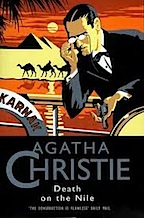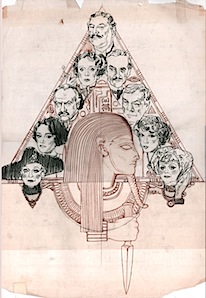 Onboard the Karnak, a ship that ferries affluent Western tourists up and down the great blue Nile, there are quite a lot of red herrings—fishy characters with secrets that Hercule Poirot, also along for the ride, must sniff out and sort through. Yet the number of plausible murder suspects is comparably small. Someone slipped into the cabin of Linnet Ridgeway and shot her in the temple with a pearl-handled pistol, but who? Enviably rich and maddeningly beautiful though she was, Linnet had few enemies among her fellow passengers. Potential killers include Andrew Pennington, an American lawyer who served as trustee of her estate, and who may have misused her funds; Fleetwood, a crew member, who resented Linnet’s efforts to sabotage his budding romance with her saucy French maid; and Jacqueline de Beaufort, a friend who grew to hate Linnet after she seduced and married Jackie’s lover, Simon Doyle. Surrounding that little group are star-crossed lovers, doting mothers, a radical agitator in disguise, at least one jewel thief, and other travelers who clearly are not murderers.
Onboard the Karnak, a ship that ferries affluent Western tourists up and down the great blue Nile, there are quite a lot of red herrings—fishy characters with secrets that Hercule Poirot, also along for the ride, must sniff out and sort through. Yet the number of plausible murder suspects is comparably small. Someone slipped into the cabin of Linnet Ridgeway and shot her in the temple with a pearl-handled pistol, but who? Enviably rich and maddeningly beautiful though she was, Linnet had few enemies among her fellow passengers. Potential killers include Andrew Pennington, an American lawyer who served as trustee of her estate, and who may have misused her funds; Fleetwood, a crew member, who resented Linnet’s efforts to sabotage his budding romance with her saucy French maid; and Jacqueline de Beaufort, a friend who grew to hate Linnet after she seduced and married Jackie’s lover, Simon Doyle. Surrounding that little group are star-crossed lovers, doting mothers, a radical agitator in disguise, at least one jewel thief, and other travelers who clearly are not murderers.
Christie, instead of delivering a full-bodied whodunit, applies her formidable powers of deception to the mechanics of the initial crime (two further killings come later) and to its psychology. The tangible clues that occupy Poirot’s attention, ranging from a bullet-riddled stole to a splash heard in the nighttime, are numerous, intriguing, and ultimately related to one another in brilliantly complex ways. Less tangible but equally salient are the signs left by the workings of human passion. Indeed, the passions that Christie conjures up for Poirot to explore are as ancient and enduring as the Sphinx, as the Pyramids of Giza, as the Nile itself.
[ADDENDUM: This past week, for the second week in a row, The New Yorker published a review essay about a Golden Age detective-story writer. This time, the focus was on Agatha Christie, with Joan Acocella using the pretext of two recently published studies (The Duchess of Death: The Unauthorized Biography of Agatha Christie, by Richard Hack, and Agatha Christie’s Secret Notebooks: Fifty Years of Mysteries in the Making, by John Curran) to fashion a “Critic at Large” thumbsucker about the Queen of Crime.  The piece isn’t particularly trenchant. Unlike Jill Lepore, who in her piece mined a new book about Charlie Chan for revelatory details about that iconic figure (and about the real-world figure who inspired its creation), Acocella covers ground that will be familiar to anyone who has an interest in Christie in the first place. Only in a passage or two does she rise above an “Agatha for Dummies” approach. She alludes to the essentially comic, and at times outright satiric, bent of Christie’s work, and she closes by citing “a melancholy note, a skepticism” that shaded the comedy somewhat. But she skates over those points—points that beg for elaboration.
The piece isn’t particularly trenchant. Unlike Jill Lepore, who in her piece mined a new book about Charlie Chan for revelatory details about that iconic figure (and about the real-world figure who inspired its creation), Acocella covers ground that will be familiar to anyone who has an interest in Christie in the first place. Only in a passage or two does she rise above an “Agatha for Dummies” approach. She alludes to the essentially comic, and at times outright satiric, bent of Christie’s work, and she closes by citing “a melancholy note, a skepticism” that shaded the comedy somewhat. But she skates over those points—points that beg for elaboration.
What seems to animate this rather superficial treatment of Christie, ironically enough, is the belief that her work lacks depth. Acocella notes the plot-vs.-character tension that defines, and limits, the classic detective-story tradition in which Christie wrote: “If she had given her characters any psychological definition, we could have solved the mystery. But as long as they are kept suspended, opaque—as they must be, in order for the book to be a puzzle—any of them could be culprit.” Christie’s tendency to accept that trade-off, according to Acocella, “shows her willingness to work by formula, and thereby to forego depth in favor of the puzzle.” That’s a fair point, but it’s also an easy point. “Depth” and “formula” are not, always and everywhere, mutually exclusive: A good sonnet, as I’m hardly the first to observe, partakes of both qualities. Nor, in Christie’s case, is the use of a formula always formulaic. In Death on the Nile, for example, the main characters display quite a lot of “psychological definition”: It’s very clear who they are, even if (thanks to their creator’s talent for misdirection) it’s not at all clear what they might do.]
Kerrie
August 26, 2010 at 8:58 AM
You might like to submit this post for the next edition (the October one) of the Agatha Christie Blog Carnival: http://acrccarnival.blogspot.com/ Submit the post at http://blogcarnival.com/bc/cprof_6057.html
Mike
September 1, 2010 at 5:53 PM
I appreciate the tip, Kerrie. I didn’t know about the AC Blog Carnival, but as a Christie enthusiast I’m very happy to know about it now.